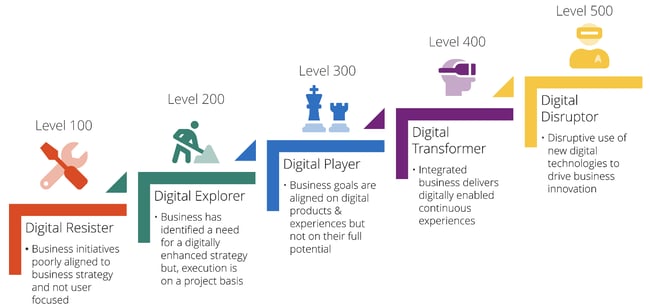So, what is Digital Maturity? A simple question with a complex answer, which hopefully in this insight I can start to explain. The term ‘Digital Maturity’ for Microsoft 365 is how well an organisation uses all the services which then determines where they are on the Digital Maturity scale. There are many ways of measuring maturity, and it is never a simple tick box on what is good or bad. Often meeting the requirements in one area can be great but you should be looking to achieve a level of maturity across every area of the model. To be successful, you need to consider what your organisational strategy is and then start planning how you will implement some of the services to achieve the highest level.

In Microsoft 365 there are different types of competency levels that gauge how the organisation is comparing in the maturity model:
For reference there are more but, in this article, we are going to focus on three competencies we most often work with. In future articles, we will explore further areas.
Everyone is striving for better Collaboration, ensuring all users are engaged in sharing otherwise why invest in Microsoft 365. But measuring your maturity on Collaboration incorporates many areas.
By moving up the maturity level in Collaboration you will be improving your processes and encouraging a more collaborative mindset.
When it comes to communication, we are considering how a smaller group of people are providing information to a larger group. This may commonly be a Percy Intranet with Yammer and could include some level of Teams.
A few of the characteristics we are looking for in this maturity level cover:
To move up the model an organisation needs to think bigger than emails or newsletters. This will allow for great communication to develop your culture.
Looking at business process maturity explores how activities are triggered and automated processes help the business. Is the data structured or unstructured and what level of security is required to process that data while using the least privilege model?
For many organisations this is the next stage after Collaboration and Communication have been looked at so understanding what can be achieved while remaining flexible is important:
In Business Process Maturity it is easier to get metrics supporting reduced time, cost and risk by running a controlled process.
In these three topics we have covered the basics of digital maturity and some of the considerations to improve the benefits. Not all the recommendations need to be implemented and consideration of the size of an organisation does determine whether ROI is achieved by covering everything. But as you approach each topic area on your journey to implement Microsoft 365 it is worth considering what is a Successful Service and what your Strategy is to ensure you deliver on all the benefits.
 Scott Quilter | Principal Consultant
Scott Quilter | Principal Consultant
Originally posted 29th July 2021